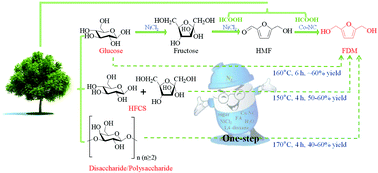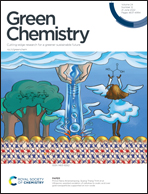Highly selective one-pot production of 2,5-furandimethanol from saccharides†
Abstract
2,5-Furandimethanol (FDM), a promising diol, is produced traditionally via hydrogenation of 5-hydroxymethylfurfural (HMF) derived from raw sugars. Because of the costly separation process and the unstable nature of HMF, direct production of FDM from raw sugars, especially polysaccharides, is highly desirable. In this work, we developed a cascade catalytic system (NiCl2/FA/Co–NC) to achieve the one-pot production of FDM from glucose and di/polysaccharides, in which NiCl2 was used as the Lewis acid, N-doped carbon confined cobalt (Co–NC) as the hydrogenation site, and formic acid as both the Brønsted acid and hydrogen donor. Under the optimal conditions of 160 °C for 6 h, ∼60% FDM yield together with full glucose conversion was achieved, and Co–NC was recyclable five times without a noticeable deactivation. Kinetic studies showed that the apparent activation energy (Ea) of glucose conversion in the NiCl2/FA/Co–NC catalytic system was approximately ∼87.7 kJ mol−1. More importantly, this new catalytic system is also highly efficient for yielding 40–60% FDM from cheap high fructose syrup and di/polysaccharides in one pot under such mild reaction conditions. We believe that this work can lead a pioneering step forward for raw biomass transformation via multi-step coupling strategies, thus showing great potential for industrial applications.



 Please wait while we load your content...
Please wait while we load your content...